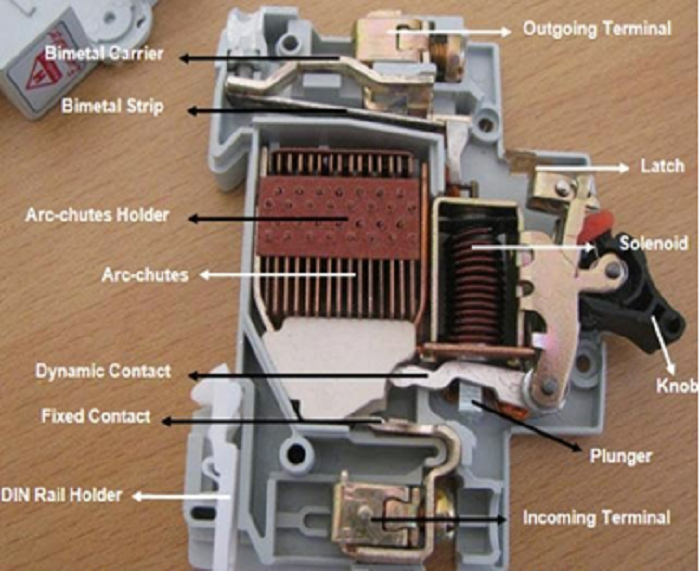Circuit breaker is a mechanical device designed to close or open contacts member thus closing or opening of an electrical circuit under normal or abnormal conditions. Circuit breakers are usually employed for the protection of electrical circuits, they are equipped with a trip coil connected to relay or other means.
A circuit breaker is a switching and current interrupting device it consists of two contacts one is fixed and other is moving contact which are touching each other and carry current under normal condition.
During normal condition the circuit breaker can be opened or closed by a station operator for purpose of switching and maintenance.
To open the circuit breaker only a small pressure is required to be applied on trigger.
A fault occurs on part of power system the trip coil of the breaker gets energized and the moving contact is pulled apart by some mechanism thus opening the circuit.
The separation of current carrying contacts produced an arc. The current is thus able to continue until the discharge ceases.
The production of arc not only delays the current interruption process but it also generates enormous heat which may cause damage to the system or to the breaker itself.
Therefore the main problem in a circuit breaker is extinguishing the arc within the shortest possible time so that heat generated by it may not reach a dangerous value.
What is Miniature Circuit Breaker (MCB)
MCB (Miniature Circuit Breaker) is a switch or electromechanical device that serves as a protective circuit of electrical installations from over current.
The occurrence of this over current, may be caused by several symptoms, such as: short circuit and overload.
MCB actually has the same function as a fuse, which will break the flow of the electric current circuit when there is over current or over voltage interference.
What distinguishes the two is when there is a disturbance, the MCB will trip and when the circuit is normal, the MCB can be turned on again (reset) manually, while the fuse will be disconnected and can no longer be used.
MCB is usually applied or used in residential installations, in lighting installations, in the installation of electric motors in the industry and so on.
The working principle of the miniature circuit breaker is very simple, when there is more current, the over current will produce heat in the bi-metal, when exposed to bimetallic heat it will bend so that the MCB contacts are disconnected (Trip).
Besides being bimetallic, the MCB usually also has a solenoid which will send the MCB when there is grounding (short circuit) or short circuit.
But it is also important to remember, that the MCB can also trip with heat (over heating) due to design / installation planning errors, such as the size of the cable that is too small to be used in high currents, resulting in heat, which over time will bimetallic and leave the MCB.

Therefore the use of installation cables must also pay attention to the maximum current standard (A) of the cable to be used, and the cable current must not be smaller than the maximum current of the circuit.
Types of MCB
According to the characteristics of the Trip, there are three main types of miniature circuit breaker, namely: type B, type C, and type D defined in IEC 60898.
MCB Type B, is a type of miniature circuit breaker that will trip when the load current is 3 to 5 times greater than the maximum current or nominal current of the MCB. miniature circuit breaker type B is a standard type trip characteristic commonly used in domestic buildings.
MCB Type C, is the type of miniature circuit breaker that will trip when the load current is 5 to 10 times the nominal current of the MCB. This type of MCB trip characteristics will be advantageous when used in electrical equipment with a higher current, such as lights, motors and so on.
Type D MCB, is an MCB type that will trip when the load current is 8 to 12 times the nominal current of the miniature circuit breaker. The MCB type D trip characteristics are trip characteristics commonly used in electrical equipment that can produce strong current surges such as transformers and capacitors.

Arcing in the Circuit Breakers
The circuit breaker has to carry large rated or fault power. Due to this large power there is always dangerously high arcing between moving contacts and fixed contact during operation of circuit breaker.
Again as we discussed earlier the arc in circuit breaker can be quenching safely if the dielectric strength between the current carrying contacts of circuit breaker increases rapidly during every current zero crossing of the alternating current.
The dielectric strength of the media in between contacts can be increased in numbers of ways, like:
- by compressing the ionized arcing media since compressing accelerates the deionization process of the media,
- cooling the arcing media since cooling increase the resistance of arcing path or
- by replacing the ionized arcing media by fresh gasses.
Hence a numbers of arc quenching processes should be involved in operation of circuit breaker.
Discover more from Electrical Engineering 123
Subscribe to get the latest posts sent to your email.

